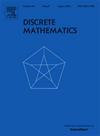Generalized Cayley graphs and perfect code
IF 0.7
3区 数学
Q2 MATHEMATICS
引用次数: 0
Abstract
A subset C of the vertex set of a graph Γ is said to be -regular if C induces an a-regular subgraph and every vertex outside C is adjacent to exactly b vertices in C. A -regular set is called a perfect code. Let G be a group and such that . Let , with and . The generalized Cayley graph of with respect to S is a graph with vertex set G and two distinct elements are adjacent if and only if . If , then the described graph is called a Cayley graph of G with respect to S. By an -regular set (resp. a perfect code) of we mean an -regular set (resp. a perfect code) in a generalized Cayley graph of with respect to some subset S. Let G be a group, , and H be a subgroup of G. In this paper, we give a necessary and sufficient condition for H to be a perfect code of . This result is a generalization of [9, Theorem 3.1] that gives a condition for a subgroup to be a perfect code in a Cayley graph of G. As another result, when G is an abelian group, we determine all pairs such that H is an -regular set of .
广义Cayley图和完美代码
图Γ的顶点集的子集C被称为(A,b)-正则,如果C引出一个A -正则子图,并且C之外的每个顶点与C中的恰好b个顶点相邻。一个(0,1)-正则集称为完美码。设G是一个群,且α∈Aut(G)使α2=id。设S∈G, α(S)=S−1,S∩{α(G−1)G: G∈G}=∅(G,α)关于S的广义Cayley图是一个顶点集G与两个不同元素G, h∈G相邻的图,当且仅当α(G−1)h∈S。如果α=id,则所描述的图称为G关于s的Cayley图,通过(a,b)-正则集(resp。(G,α)的完美码(a,b)表示(a,b)正则集(p。设G是一个群,α∈Aut(G), α2=id, H是G的一个子群,给出了H是(G,α)的一个完全码的充分必要条件。这个结果是对[9,定理3.1]的推广,该定理给出了G的Cayley图中子群是完美码的一个条件。另一个结果是,当G是一个阿贝群时,我们确定了所有对(a,b)使得H是(G,α)的(a,b)正则集。
本文章由计算机程序翻译,如有差异,请以英文原文为准。
求助全文
约1分钟内获得全文
求助全文
来源期刊

Discrete Mathematics
数学-数学
CiteScore
1.50
自引率
12.50%
发文量
424
审稿时长
6 months
期刊介绍:
Discrete Mathematics provides a common forum for significant research in many areas of discrete mathematics and combinatorics. Among the fields covered by Discrete Mathematics are graph and hypergraph theory, enumeration, coding theory, block designs, the combinatorics of partially ordered sets, extremal set theory, matroid theory, algebraic combinatorics, discrete geometry, matrices, and discrete probability theory.
Items in the journal include research articles (Contributions or Notes, depending on length) and survey/expository articles (Perspectives). Efforts are made to process the submission of Notes (short articles) quickly. The Perspectives section features expository articles accessible to a broad audience that cast new light or present unifying points of view on well-known or insufficiently-known topics.
 求助内容:
求助内容: 应助结果提醒方式:
应助结果提醒方式:


